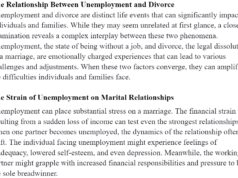SPONSORED CONTENT
By Sean Barret, who is barred in Connecticut and who focuses in family law with over 12 years of experience in divorce cases.
The rate of divorce in the U.S. among those age 50 and older has doubled in the past twenty-five years, according to the National Center for Health Statistics and the U.S. Census Bureau.
In 2015, 10 out of every 1,000 married people age 50 and up were divorced, doubling the rate from 5 in 1990. In ages 65 and older, the rate tripled; it is now 6 people per 1,000 married people.
‘Gray divorce’, defined as a parting of ways of people over age 50 after being married for at least twenty years, is a growing U.S. trend; unfortunately, it can greatly negatively impact the couple’s joint retirement fund.
Because a divorce will intrinsically affect funding your retirement plan, it is advisable to prevent financial difficulties due to an impending divorce by working with a licensed financial planner and/or marital professional, such as a mediator.
Reasons for this increase of late-in-life separations point to the possibility that once romantic partners no longer have anything in common once their children grow up and leave the home.
Although couples may no longer have a common goal and feel like they no longer relate to each other, a divorce is not always the logical next step. It is always helpful to discuss options with licensed professionals and make sure you are taking care of both your financial and emotional future.
Whatever their reasons, couples need to think through the ramifications of this decision and mitigate the financial and emotional consequences. Each partner will be living on less income than before, and any existing property and financial accounts — such as pensions, 401(k) plans, IRAs, 457 or 403(b) accounts — will need to be divided.
There may be an expensive legal bill to both partners, and it may include a QDRO (Qualified Domestic Relations Order); if so, they will need to hire an attorney who specializes in this financial instrument.
Any division of property will be a loss for each individual; by addressing these issues early in the process you can ensure you don’t run out of money in your retirement, a common fear in older people.
In addition, the couple may have other financial stresses affecting their financial stability. Their adult children may be living at home; studies show that one third of those aged 18-24 currently live with their parents.
In addition to these “boomerang children”, the couple may also be taking care of their elderly parents. Both situations can put stress on the couple’s assets.
The most prudent course of action is to plan for these possibilities. Working with both a financial professional and a marital mediator throughout the process will allow the individuals to prepare for their future, and consider whether divorcing is the best course of action after all.











![Saturday News: “Trump’s latest tariff TACO probably won’t make your life more affordable”; “The Epstein Email Cache: 2,300 Messages, Many of Which Mention Trump”; “[MTG] questions if Trump is still the ‘America First’ president”; “Jim Ryan tells all: ‘What did the Governor know, when did he know it?’”](https://bluevirginia.us/wp-content/uploads/2025/11/montage1115-100x75.jpg)

